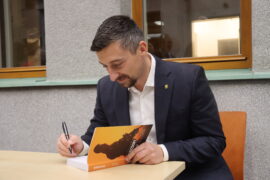
03 Bronze Sword, Bohemia, 1 300-1 000 B.C.
Fotogalerie
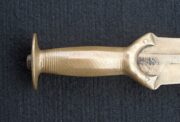

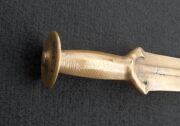

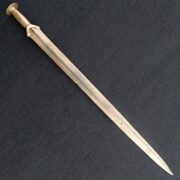
The first specialised weapons for man-to-man combat appeared with the knowledge of metalworking. Already in the first half of the 3rd millennium B.C., towards the end of the Neolithic period, the first metal weapons, copper daggers and axes, were produced. However, this period did not last long and by the end of the third millennium the processing of bronze, which was much more suitable for the production of weapons, had already spread rapidly. As an alloy of copper (approximately 90%) and tin (approximately 7-10%), bronze was not only sufficiently hard, but also very malleable in the hands of skilled craftsmen. Older bronze swords had longer blades and were used primarily as stabbing weapons. Later, they started to be made with a wider leaf blade, intended for both stabbing and cutting. The blades of such swords were cast in one piece with a narrow tang to which the grip scabbards were attached. The swords had no guards.
This sword was allegedly found in the Vltava River bank near Hlavkov Bridge around 1950. Its authenticity was consulted with the archaeological department of the National Museum, the Prague City Museum and the Institute of Archaeology. The authenticity was finally confirmed by a comparative X-ray image of the hilt with the authenticated original from the collections of the Prague City Museum, and a spectral analysis of the metal.
Total length 740 mm, blade length 650 mm, blade width 40 mm, weight 900 g.
Aktuálně

Výzkum u českých krajanů v Chorvatsku
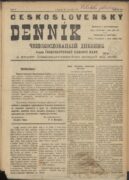
Československý deník sehrál v životě legionářů v Rusku velmi důležitou roli. Poprvé vyšel v prosinci 1917

Děkujeme za podporu pro válečné veterány. Sbírka DiGiMÁK vynesla 450 tisíc korun

Tak trochu zamrzlé spojení
